Wild dogs
by Ted Mitchell
Hunter 3
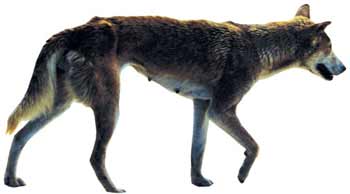 Dingoes have been known to be in Australia for nearly 3500 years and
even though they may not be truly indigenous to this land, I believe
that they are a part of our heritage. As a hunter, I am also a
conservationist and would hate to see this beautiful animal completely eradicated.
Dingoes have been known to be in Australia for nearly 3500 years and
even though they may not be truly indigenous to this land, I believe
that they are a part of our heritage. As a hunter, I am also a
conservationist and would hate to see this beautiful animal completely eradicated.
Scientific tests have shown that dingoes prefer native game to stock. Unfortunately, when land is cleared for stock, native game disappears and the dingo has to eat. It will supplement its diet of native game with meat from dead beasts or sheep that have died from overstocking or disease, but when times are hard, such as during a drought, the dingo will pull down weak or young domestic stock.
The name dingo was probably derived by mistake, as the early settlers heard the Aborigines calling the wild dogs ‘tingo’, which was the Aboriginal word for their tame camp dogs. It was quite possible that this was misunderstood and corrupted into ‘dingo’. In the coastal areas, only about 20 to 25 per cent of wild dogs are pure dingo, whereas in the central arid areas they are about 85 to 90 per cent pure.
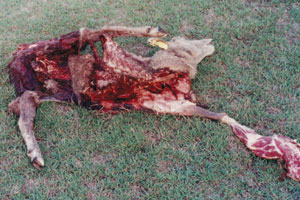
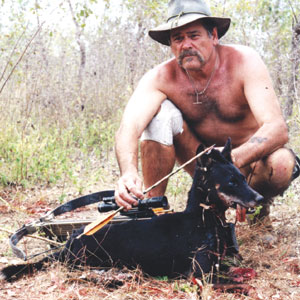
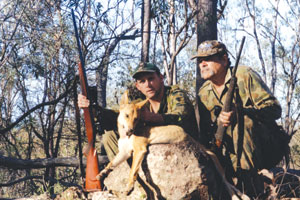
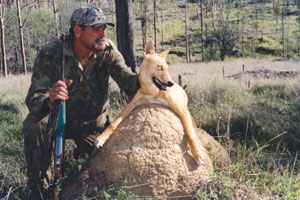
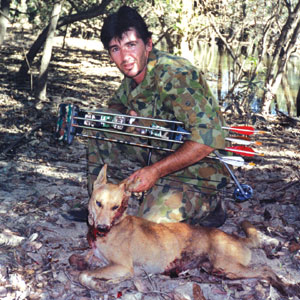
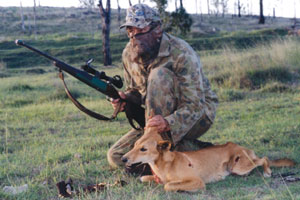
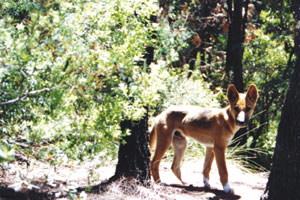 Most people think that pure-bred dingoes are yellow-ginger in colour,
which is most common, but in fact they can be all white (a small
percentage), yellow, black or black and tan, as well as many variations
of these colours. The only characteristic common to most pure dingoes
is a patch of white on the feet and a white tip on the tail.
Most people think that pure-bred dingoes are yellow-ginger in colour,
which is most common, but in fact they can be all white (a small
percentage), yellow, black or black and tan, as well as many variations
of these colours. The only characteristic common to most pure dingoes
is a patch of white on the feet and a white tip on the tail.
Drought. It’s a dreaded word for the man on the land and we were in the grip of one of the worst ones this century in the south-east corner of Queensland. There were 500-hectare paddocks that didn’t have enough feed on them for more than a few head of cattle and to make things worse, in some areas, bush fires had burnt the last dry feed down to bare dirt. With no rain and the constant winds dragging the last bit of moisture from the soil, the farmers in this area were in dire straights.
As if this wasn’t enough, farmers had the added problem of wild dogs pulling down calves and sheep.
My eldest son, Ted Jr, is the local animal control officer in this area. He has eradicated about 30 wild dogs in the past 12 months, but they still keep coming in from outlying areas and from irresponsible people dumping unwanted pets, which pair up and breed with dingoes, creating a particularly troublesome type of wild dog that is unafraid of humans.
A friend living on the land in this area phoned me one day quite distressed. Three wild dogs had lured his pet jack russell into the bush and killed him in plain view. Not long after, two other property owners rang. One was losing calves and the other sheep. The dogs were blatantly unafraid - both property owners told of wild dogs bailing them up and growling and barking at them.
After spending a few days working out where the dogs were roaming and to what pattern, I headed out to attempt to howl them in. My mate Grant came out with me the first couple of times and we howled our guts out - to no avail. Then, one morning, my mate Bob rang to let me know that three dogs had just bailed him up while he was riding his paddocks on horseback. He yelled at them and they took off into the thick scrub. That afternoon, grabbing my .223 and a pair of binos, I headed off to have a go at them.
After being told exactly where this confrontation had taken place, I headed down the paddock.
Setting myself up in a good position, I commenced howling. After 20 minutes, I moved about 50 metres to get a better look around some trees. I had only howled twice when a loud growl sounded behind me. Looking back, the sight of three wild dogs snarling and growling made me grateful to have my rifle.
Turning slightly to get a shot at them, they spotted my movement and took off into the thicker scrub, still growling and barking as they went. Following them through the scope, I noticed a clearing that they were going to have to run through. Squeezing the trigger as the crosshairs crossed the lead dog’s chest, I was rewarded with a solid hit. The dog spun around and let out a loud yelp, which made one of the remaining two dogs come back for a look. Bang! The .223 spoke again and another dog bit the dust. When I arrived at the homestead, my mate was pleased to hear that two of the marauders had been shot.
Only a week had passed when I received yet another call from Bob. There were more dogs and they had just killed three calves. Grabbing my new gun, a Ruger Mod 77 in .260 Rem, I headed out again. I had just worked out a load of 41.5 grains of AR2208 behind a 120-grain Nosler ballistic tip and they shot well, scooting along at more than 3000fps.
Bob explained where the dogs had killed the last calf and we worked out the best way to approach the remains.
Parking the Toyota downwind from their most recent kill, I stalked slowly up the gully, stopping to glass the area every 50 metres or so. The country was dry and the dogs blended in with the land perfectly. Getting to within 200 metres from where the remains of the calf should have been, I was slowly glassing the area when a big yellow bitch jumped up on a log and looked right at me. As I dropped my glasses and chambered a round, she took off across the flat with a darker dog following her. Shouldering the .260 and putting the crosshairs just in front of her chest, I squeezed the trigger, sending a ballistic tip unerringly on its way. It took her about three inches behind the shoulder. Spinning around she gave one yelp and expired.
Following the other dog with the scope, I was just about to fire when he propped and ran back to the bitch and stopped. Sitting down and shooting over my knee, I put a 120-grain BT right through both shoulders and he dropped dead on the spot. Checking to make sure that there were no more dogs heading off in different directions, I headed over to check out the dogs. They were both beautiful dogs, in quite good condition and almost pure in colour and size. I felt sad that I had to shoot them, but when they start killing stock, there is only one way to stop them.
Back at the homestead, the property owner was rapt, “Just keep coming back if you will,” he exclaimed. I assured him that I would come back and do regular checks on the local properties.
The next few evenings were spent trying, unsuccessfully, to howl the dogs in on another property where they had killed 16 sheep. Many dogs that are shot are just lucked onto. Not too many hunters specifically go out to shoot dingoes and get one. Probably the best time to howl them up is in their breeding season, which can run from April to June. They are more likely to answer you and come running.
Later that week, there was a meeting held at a local hall to determine how to rid the area of the wild dogs that had been barking and snarling at landholders and their children and attacking their property dogs. Poison baits were ruled out, as most landholders were against this method of handling the problem. Grant, my son Brenton and I were elected to try to shoot the offending dogs. Our shoot was sanctioned by the local council officers and the Queensland government rural lands officers, both of which attended the meeting. It was good to know that the local landholders trusted us to help them with their problems.
A few days later, Grant and I headed out to inspect one of the new properties we had the run of. Hunkering down at the top of a good gully I began howling. Almost immediately, a dog answered. After a while he stopped howling. “He’s coming”, whispered Grant. He came all right, right behind us. As he winded us he took off. Both Grant and I fired. Mortally hit, the big dog tumbled down the hill to the lantana below.
Half an hour later I was howling again at the top of another good hill. Another dog answered and we howled to each other for 20 minutes or so. Then quiet. “He’s coming,” I whispered. “I reckon he will follow the track rather than come down through the lantana.” Grant agreed and we moved quietly to the track.
It would have been one kilometre from where he was howling to where we were waiting and three kilometres by walking the track. Fifteen minutes later there he was - only he was a she. Grant took her out at about 20 metres. She had followed the track right around to get in behind us - only we outsmarted her this time and she wouldn’t get another chance.
To date we have taken 22 dogs in the Ripley Ranges and will no doubt take more. Hopefully the farmers will be happy and we will have helped enhance the role of shooters assisting the man on the land.
Note: The status of the dingo as a ‘native animal’ may vary between states. Please check with the National Parks and Wildlife Service in your area.
